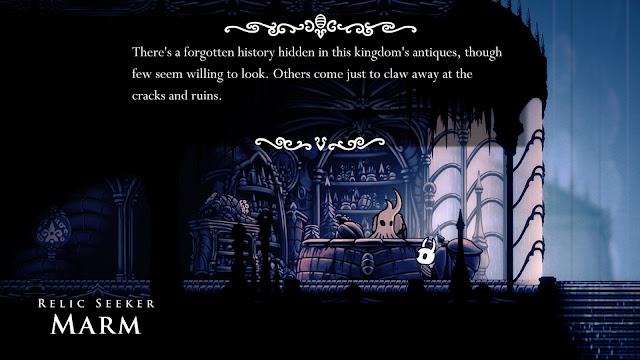Hollow Knight (Review)
Hollow Knight starts off slow. The first area that the player discovers - the Forgotten Crossroads - is bland and ridden with the most basic of enemy types, accompanied by a sombre and melancholic tune that does nothing to pique the player’s interest. After a gritty and difficult fight against the game’s first of many spectacular bosses, the player emerges from the tunnels, ready to put down their controller and never return. When from the dust and ash emerges Greenpath, a lush and bright pilgrim’s path. It is in this second of the early game areas that Hollow Knight reveals its charm, beauty, tune, and atmosphere.
Hollow Knight drops you into the forgotten and ruined ancient kingdom of Hallownest. The player takes control of a mysterious and voiceless protagonist, only known as the Knight. It is up to the player to explore this desolate place and uncover the secrets and history of how it all came crashing down. The kingdom of Hallownest is made up of many different and unique environments, all interconnected in a maze of shortcuts and passages.
The bubbling swamps of the Fungal Wastes are a far cry from the cold and unforgiving mines of the Crystal Peaks, and exploring these unique settings is a joy, although the game's save system that respawns the player at the last bench they sat on, can be rather unforgiving at the start, especially when the player is less skilled and the world vastly unexplored.
Exploration and straying off the beaten path is meaningfully rewarded in Hollow Knight. Fighting and defeating optional bosses usually provide the player with interesting charms that be can be equipped to provide unique buffs during combat. Collectables found across the world can be used to upgrade the Knight’s nail - an equivalent of a sword in Hallownest - or be cashed in for some of that sweet-sweet Geo- the currency of the kingdom.
The Metroidvania design philosophy that this game employs ensures that the upgrades that the player receives almost always open up previously inaccessible locations, like a double jump for a ledge that’s too high to reach or a charm that allows you to swim through pools of acid. Discovering new sights and hidden locations are as satisfying as reaping the rewards they provide.
The combat is Hollow Knight is simple, yet it never got boring throughout the entirety of my 40-hour long playthrough. The Knight’s main weapon is its trusty nail which can be upgraded throughout the player’s journey. Alongside the nail in fights, the Knight has a comprehensive spell system that can be used by consuming soul- a meter that refills upon striking enemies. This same soul meter is also used to heal, opening up interesting combat scenarios where the player must decide whether to use the little soul they have to attack or heal. This system also encourages an offensive playstyle that requires constant retaliation in order to keep the Knight from dying.
Charms also provide passive or active abilities such as creating a shell to protect the player while they are healing or a charm that increases damage when only one health mask is left. The challenge in Hollow Knight’s simplistic combat system is ever-present, with intelligent enemies that won’t stand back in a fight. Mastery of the nail is essential and develops throughout the entirety of time one spends in this world.
Hollow Knight’s charm is present in its hand-drawn environments, animations, and characters. The environments have multi-layered backgrounds, animated to show the rustling of leaves or the scurrying of foes. The art helps make each and every room in Hollow Knight feel densely packed, adding to the aesthetic of this underground kingdom.
Simple actions like pulling out a map or swimming are immaculately detailed. It is hard not to notice and be amazed as the Knight pauses to pull out a map from inside of its cape or at how its cape floats while swimming. These tiny details add tons of immersion to Hollow Knight and really shows the amount of care and passion that developers Team Cherry have poured into the game.
Christopher Larkin’s work on Hollow Knight’s soundtrack is incredible. From the fast-paced tunes that play during boss battles to the background tunes that accompany exploration, every aspect of Hollow Knight’s score strikes home. Little sound effects like sizzling acid or the shrieks of pain released by enemies upon death help increase player immersion in this already incredibly realised world.
While there may not be any dialogue exiting the protagonist’s mouth, the inhabitants of Hallownest have their own language- a sort of yapping gibberish nonsense that is actually pleasantly fun to listen to. It creates comically hilarious moments, ones that are often sorely needed provided just how difficult this game can be at times.
Spotify: https://open.spotify.com/album/4XgGOMRY7H4hl6OQi5wb2Z?si=5jewy9uIRkifCR5x6-nV7Q
When it comes to storytelling, Hollow Knight uses its world to tell the tale of the kingdom of Hallownest. Environmental signs, NPC dialogue, and Mossbag are utilised to show a story, instead of just telling one. While I did not pick up much about the lore and history of Hallownest throughout my journey, keen and interested players can spend hours uncovering secrets of this kingdom and scouring wikis and Reddit threads formulating theories to answer the unanswered.
Team Cherry’s Hollow Knight is a modern classic. Its simplistic combat, deep and rich lore, and interesting expansive world are supported by great art and sound design. While a slow start is not the best impression on a new player, those sticking around will slowly but surely uncover all the great things Hollow Knight has to offer. And there are a lot of them.
Name: Hollow Knight Developer: Team Cherry Initial Release Date: 24th February 2017 Platforms: Nintendo Switch, PS4 (Reviewed), Xbox One, PC Score: 4/5










Loved it, writing gives me chills
ReplyDelete